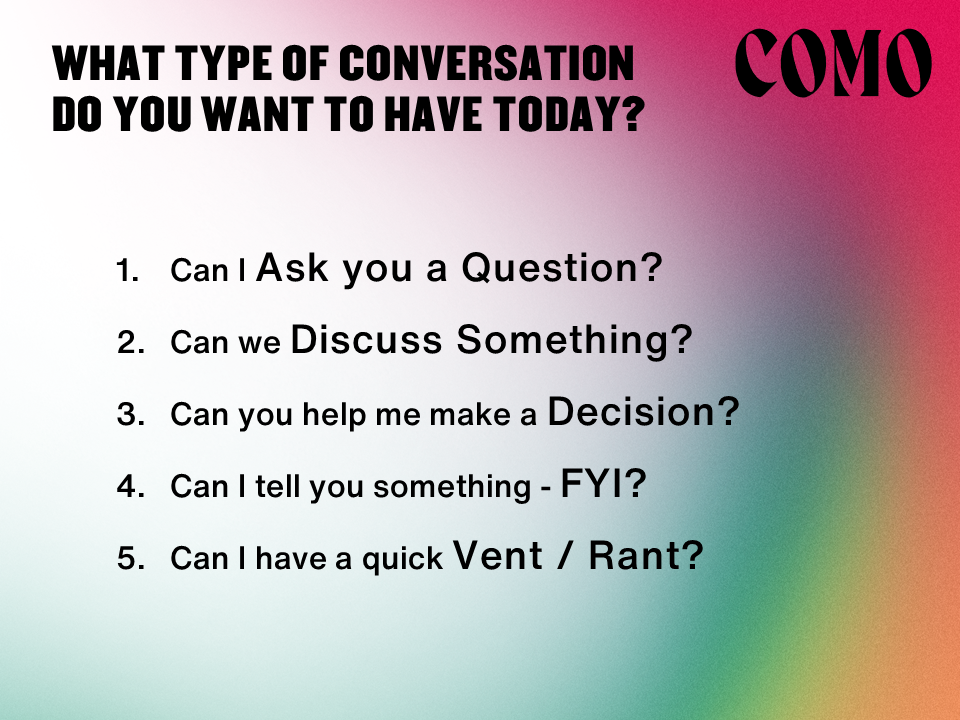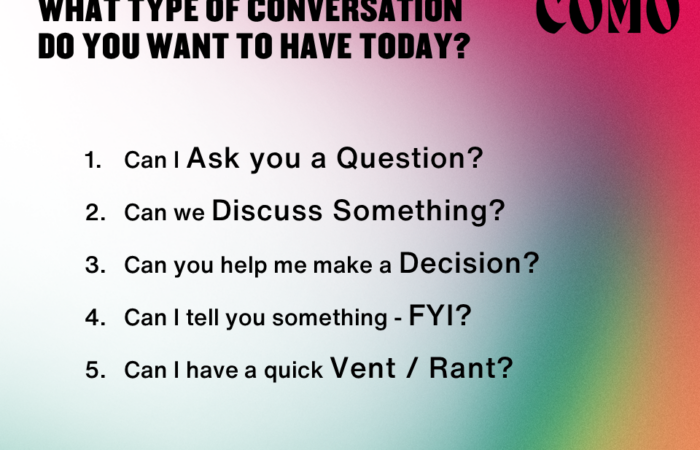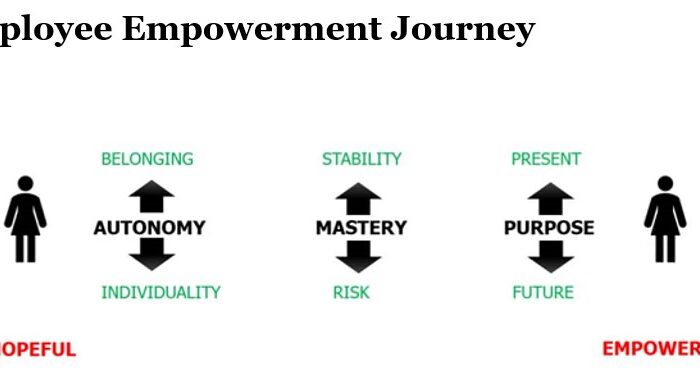The 5 Different Types of Conversations. In Blackboard Fridays Episode 71, Jacob talks about Leadership and Productivity. Need this implemented into your business? Talk to the international business advisor who can do exactly that – Contact Jacob, Learn More, or Subscribe for Updates.
Have you ever wasted an hour in a meeting, that could have been an email instead? Or seen a simple decision drag on for weeks through an email chain, because nobody wanted to make a decision?
We all know “Communication” is imperative in business – but do you appreciate the different types of communication that take place? I’m talking about the time you stuck your head into someone’s office to give them an “FYI” … and it suddenly turned into them sharing all of their ideas (even though the decision had already been made).
Or that person who came to you needing a rant, to healthily get something off their chest, but which you thought was a problem needing a solution so you spent all day trying to help them. They didn’t need your help!! You were wasting your time!!
And with so much time wasted through the wrong type of conversation, we also lose the opportunity to accelerate business by having the RIGHT chats.
So email this week’s video to your entire team. Ask them to write down the 5 Types of Conversation, and moving forward to share exactly which type of conversation they want to have.
What you say to your team is important. Why you’re saying it is even more powerful. And this simple tip will get you there more often.
Who is Jacob Aldridge, Business Coach?
“The smart and quirky advisor who gets sh!t done in business.”
Since April 2006, I’ve been an international business advisor providing bespoke solutions for privately-owned businesses with 12-96 employees.
At this stage you have proven your business model, but you’re struggling to turn aspirations into day-to-day reality. You are still responsible for all 28 areas of your business, but you don’t have the time or budget to hire 28 different experts.
You need 1 person you can trust who can show you how everything in your business is connected, and which areas to prioritise first.
That’s me.
Learn more here. Or Let’s chat.
Transcript
This Business Would Be Easier Without the Other Staff
It’s a (sad?) reality of most workplaces: you have to communicate with other people.
And in fact, if like me you get to interview thousands of people across a whole range of different industries, you’ll find that the number one cause of frustration for them is that communication and those other people.
Now we’ve talked in previous episodes of Blackboard Fridays about creating more effective meetings that have momentum and energy, about having clear roles and responsibilities so that each person knows exactly what they’re tasked with doing. We still need to communicate.
In that regard, I’ve found having this very very simple framework is an easy way for all of the members of your team to communicate more effectively and more efficiently with each other.
It’s as simple as communicating at the start of a conversation what type of conversation you’re trying to have. And while this might sound too basic, or even a little cringeworthy (“Wait up Bob, is this an FYI or a Rant?”) in practice it’s one of the simplest and most powerful ways to create more time and better outcomes between team members.
The 5 Types of Business Conversation
So what type of conversation are you trying to have? In other words, what is the purpose of having this conversation? Because there are these 5 different, often competing, purposes … and when you have two individuals having two different types of conversation, it gets ineffective and frustrating FAST.

Purpose #1: Hey, can I just ask you a question?
This means that the person instigating the conversation is simply looking for an answer or a solution to their problem.
This can be very very quick conversation, but is often confused (with time vampire results) with the second type.
Purpose #2: Hi, can we please have a discussion about this topic?
Do you see the difference between these first two?
If I’m asking you a question you can give me a very direct answer. If we’re going to have a discussion, we both know in advance that this conversation is going to take more time.
Ideally, we could schedule that at a time that’s convenient for both of us. “Hey not right now I don’t have time for a proper discussion but can we do it in an hour?” By understanding in advance the type of conversation we can put it at a time that’s more effective.
Purpose #3: Can You Help Me Make a Decision?
The third one is about making decision and again, can you see the subtle difference between a Discussion and a Decision?
If I’m going into a conversation knowing we need to make a decision then I could hone in and focus on achieving that outcome. If we’re just having a broad discussion – we don’t need to decide anything – then we don’t need to force ourselves towards that end.
When you’ve got one person having a Discussion, and another having a Decision conversation, friction will ensue.
Purpose #4: Can I just tell you something? FYI – For Your Information
The fourth type is a ‘communication’ this is almost the opposite of the ‘ask’. Where the ask is ”Can I ask you a question?” (I’m looking for a response) the ‘tell’ communication is more of an FYI, a ‘for your information’ (I am not looking for a response).
“Hey just so you know they’re going to be putting a birthday cake on in ten minutes.” I’m not asking for your opinion on which cake to choose. I’m not discussing the merits of post-lunch sugar consumption. You didn’t have a say in deciding what time the cake was being served. Just go, sing, enjoy.
A lot of ’FYI’ communication can be done by email or internal message services (like Slack, Teams, WhatsApp. Increasingly however, I’m seeing businesses set behavioural norms around less email and more face-to-face communication (especially in hybrid workplaces where you don’t see colleagues in person very often).
If that’s you and you’re getting frustrated at the time that that conversation is taking: run this process. If it’s an FYI, share this piece of information, and avoid falling into a whole discussion about it.
Purpose #5: I Need to Rant!
Welcome to the last, the most misunderstood, and sometimes the most important type of conversation: the ’rant’.
You know this experience, your team know this experience (and indeed I hope you have shared this link and image with you team?): you come out of a meeting or hang up the phone and you’re just feeling ‘blah blergh aaagh!’
It would actually be healthy to just need to dump that ‘blah!’ onto somebody else – not to make it their problem, but just to release that spit off your liver.
You’re not asking a question. You’re not looking for a discussion about what happened, and you don’t want a decision to change anything. You just need to get it off your chest in a healthy, inter-personal space.
There’s nothing worse when you just want to get something off your chest than having the other person in that conversation jump in and try and solve that problem for you! They turn a 30-second ‘blah!’ into a 10- minute discussion, going over and over and over that phone conversation – when all you wanted was to just get in, get it out, and get on with your day.
Give your team permission to have a rant as long as they set the expectation in advance that I’m here to rant. “If it’s OK, can you please let me dump this, and let’s both get on with our day.” Allowing that to happen means you don’t have that energy building up within your team.
Implementing the 5 Different Types of Business Communication
Think about some of the least effective, most frustrating conversations you’ve had as a team recently.
Almost certainly in every one of those situations, you had different individuals having different types of conversations – often with nobody realising it. You might have had five people in that meeting (which should have been an email anyway) all with a different context, trying to have different types of conversation about the same content. No wonder nothing moves forward.
Be clear in advance. Many of my clients have the image about printed and stuck on their door, wall, or the back of their computer monitor – and nobody starts a conversation without referring to the list, and expressing the type of conversation they wish to have.
Is it awkward pointing your team member to a colourful diagram when they come into your space? Absolutely, for a little while at least. You know what’s even more awkward? Spending 20 minutes discussing cake recipes, and missing out on the actual cake eating!
It’s also pretty sweet to improve communication throughout your whole workplace, with something as simple as this list. Have your team watched the video yet?
Next Steps
Want to learn more about how this can apply to your business? It costs nothing to chat:
- Email me jacob@jacobaldridge.com (I read them all)
- Call, Text, or WhatsApp me +61 427 151 181
- Or just Subscribe https://jacobaldridge.com/about/subscribe-to-jacob-aldridge-com/ to stay in touch




